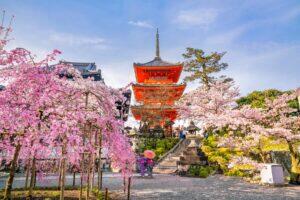Fodor's Expert Review Koryu-ji Temple
One of Kyoto's oldest temples, Koryu-ji was founded in AD 622 by Kawakatsu Hata in memory of Prince Shotoku (AD 572–621). Shotoku ruled during an era before the founding of Kyoto. When the capital was to be moved from Nara, the Hata clan was living in this area and invited the present emperor to build a new capital on their lands. Prince Shotoku was the first powerful advocate of Buddhism after it was introduced to Japan in AD 552 and based his government on its dictates.
In the Hatto (Lecture Hall) of the main temple stand three statues, each a National Treasure. The central statue, a seated Buddha, is flanked by the figures of the Thousand-armed Kannon and Fukukenjaku-Kannon. In the Taishi-do (Prince Hall) is a wooden statue of Prince Shotoku, thought to have been carved by him personally. Another statue of Shotoku here is believed to depict him at age 16, when it was carved.
The most famous of the Buddhist images in the Reiho-den (Treasure House) is the statue of Miroku... READ MORE
One of Kyoto's oldest temples, Koryu-ji was founded in AD 622 by Kawakatsu Hata in memory of Prince Shotoku (AD 572–621). Shotoku ruled during an era before the founding of Kyoto. When the capital was to be moved from Nara, the Hata clan was living in this area and invited the present emperor to build a new capital on their lands. Prince Shotoku was the first powerful advocate of Buddhism after it was introduced to Japan in AD 552 and based his government on its dictates.
In the Hatto (Lecture Hall) of the main temple stand three statues, each a National Treasure. The central statue, a seated Buddha, is flanked by the figures of the Thousand-armed Kannon and Fukukenjaku-Kannon. In the Taishi-do (Prince Hall) is a wooden statue of Prince Shotoku, thought to have been carved by him personally. Another statue of Shotoku here is believed to depict him at age 16, when it was carved.
The most famous of the Buddhist images in the Reiho-den (Treasure House) is the statue of Miroku Bosatsu, who, according to Buddhist belief, is destined to appear on Earth in the far-off future to save those unable to achieve enlightenment. Japan's first registered National Treasure, this exquisite wooden statue is thought to date from the 6th or 7th century. This may be the most captivating, ethereal Buddhist image in Kyoto. The epitome of serenity, the image's gentle face is one of the finest examples of 6th-century wooden carving in the world. Other images represent a progression of the carving techniques for which Japan is renowned.
READ LESS







